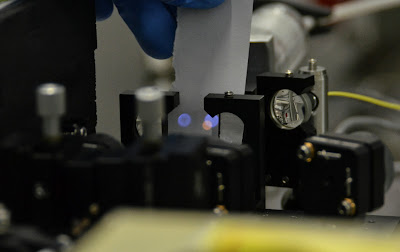Spring's back - at least for now, so the flowers are out in full force!
The Durham guys will leave here with a misleading impression of what the Karoo looks like...
Perfect for a morning stroll up to the telescope, alarming a small herd of bokkies along the way.
Up at SALT we found Denville running the primary mirror cleaner that showers CO2 snow all over the segments to remove loose dust & dirt.
While down in the coating room Willa was busy washing segments that have been removed from the array for recoating.
Here's the Kestrel Cam view of David giving budding SALT Astronomer/Operator Emma the tour...
Our mission for the day was to replace the damaged fibre at the input side of the High Stability (HS) mode with one of the spare fibres. Since the HS mode has a gap in the fibres for the double-scrambler & the
iodine cell, the repaired end will have to be aligned with its buddy on the other side of the optical chasm (behind the small lenses on the right). Here's the spare after it'd been gently extended out of its miniflex tube. This was necessary so that the glass ferrule at the end could be bonded into its stage assembly.
A tiny drop of vacuum-compatible Norland 88 optical adhesive was put on the back of the lens...
Then the fibre was pushed into place against it.
& zapped for 30 seconds with a UV lamp that quickly cures the adhesive. Just when you thought clean room gear couldn't look much sillier - out comes the funky UV eye-protection... Meet The Jürgenator!
The whole lens + fibre's then eased into position.
& then blasted with UV light for another 2 minutes.
So we're back in business! You can see the hair-like fibres coming out of the white miniflex tube & the 2 that are in use (the star & sky fibres) going into the adjustable stage assemblies. The broken one & the remaining spare are visible too but do not extend as far out of the miniflex tube.
With the new fibre in place, it was time for another of Jürgen's nifty alignment tricks! Shine bright yellowish light in from the telescope end of the fibres & direct bright blueish light in through the back of the slicer optics.
The latter illuminates all the sliced mode fibres, including the HS pair we need to align.
One can then view the different coloured spots from the 2 ends & line them up! Here you can see the 2 blue spots from the slicer side & the yellow spot from the new fibre.
It's then a simple matter to adjust the stages on the input side to move the yellow spot to where it needs to be.
That's close enough for now, we'll peak it up using the exposure meter when that gets connected in the next couple of days.
We continued with the throughput tests in the afternoon.
Doing the two LEDs for the red camera. Their wavelengths are 591 nm for the amber one & 625 nm for the red.
A puzzling feature emerged when taking the red throughput measurements: a streak that's sharp at one end & tapered at the other. It's not there if no light's fed into the system, but if there is light going in, the streak appears, regardless of whether or not the shutter's open.
Weirder yet, its brightness is independent of exposure time & the orientation changes when you read the chip out through different amplifiers. It seems that this feature gets triggered by the presence of some stray light & then a trap in the CCD hampers the readout process & produces the streak - the orientation of which is determined by the direction of the readout. We'll have to try baffling up the fore-optics tomorrow to see if we can kill this.
Here are some preliminary results for the star & sky fibres - we still need to repeat all the measurements for the HS fibre that was replaced today & do some other tests once we sort out the stray light issues.
This evening we decided to go play around on the old thirty inch telescope to give the northerners a dose of the southern sky. Turns out this is the very telescope that Ray used during his first
observing run, in 1979! & believe it or not - the same instrument
(a single-channel infrared photometer) is still in use!!
The seeing was excellent, affording us great views of various small globular clusters, Neptune & Uranus, a couple of nebulae & finally the spectacular 47 Tuc - the second largest globular cluster in the sky: WOW :) If you're wondering why the astronomy-mad Jürgen's not in this photo - it's because he'd died & gone to heaven earlier in the proceedings...
























No comments:
Post a Comment